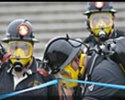
Nine Ohio mine rescue teams will be assigned the same emergency problem and will be evaluated by state and federal mine inspectors on their procedures and speed. Two courses will run simultaneously and teams will be sequestered until it is their turn to compete.

The Oct. 6-7 and Nov. 17-18 events in Arlington, Va., are part of the National Nanotechnology Initiative's nanoEHS series.
The site's lack of eyewash or shower stations near where employees were exposed to corrosive materials were among the 10 serious health violations for which OSHA cited the Georgia company.

John R. Mulhausen, Ph.D., CIH, CSP, will be presented with the Henry F. Smyth Jr. Award at the 2009 Professional Conference on Industrial Hygiene being held Oct. 3-6 in Vancouver, Canada.
The serious violations OSHA unearthed related to inadequate process safety management of highly hazardous chemicals, lack of emergency preparedness and response procedures, and poor respiratory protection for workers.

The newly downloadable document addresses methods for controlling silica such as wet cutting during construction operations and using vacuum dust collection systems.
A panel presentation and discussion on "The State of the Granite Debate," focusing on the issue of radon and radioactivity from granite countertop materials, will be part of AARST's 21st International Radon Symposium next week.

With more participation this year than ever before, more than 100 radio stations in some 20 states are planning to help raise awareness of mesothelioma by playing a Warren Zevon song followed by a 20-second segment about the incurable disease on Saturday, Sept. 26.
Treating second-degree burns with a nanoemulsion lotion sharply curbs bacterial growth and reduces inflammation that otherwise can jeopardize recovery, University of Michigan (UM) scientists have shown in initial laboratory studies.
Hospital rooms can harbor germs that can cause serious infections, especially for elderly patients, those with weakened immune systems, and those who have undergone surgery or who have catheters or tubes inserted in the body.
Imagine a polka-dotted, postage stamp-sized sensor that can sniff out some known poisonous gases and toxins and show the results simply by changing colors.

The agency has published proposals to identify the group as Substances of Very High Concern because of their carcinogenic, mutagenic, and/or reprotoxic properties and potentially serious effects on human health, or for persistent, bioaccumulative environmental effects. Comments to ECHA are due by Oct. 15.
The American Industrial Hygiene Association® (AIHA) recently announced the results of the 2009 election for the Academy of Industrial Hygiene Council.
The settlement is related to a release at the company’s ammonia and nitric acid manufacturing facility in Deer Island, Ore., on Sept. 29, 2008. EPA alleges that the company failed to notify the appropriate emergency response entities until approximately 11 hours after the release occurred.
Exposure to high levels of xylene and ethylbenzene can cause a variety of human health effects, including harm to the nervous system, fatigue, general weakness, memory loss, and visual problems.
In addition to issuing willful, repeat, and serious citations to the company, OSHA also issued it a notice of failure-to-abate citation relating to its failure to implement a respiratory program, institute a medical surveillance program for workers overexposed to chromium VI, and develop and implement a hazard communication program for workers exposed to caustics and corrosives.
Work continues on new approval criteria for various respiratory categories, and the branch chief at NPPTL asks whether users have additional needs that NIOSH could address.
The standard applies to the evaluation of vibration on rotodynamic pump applications, specifically when the vibration measurements are made on non-rotating parts (bearing housing vibration).
"OSHA has inspected this company on five occasions going back to 1997, resulting in numerous violations, including many we found again on this most recent inspection," said OSHA Area Director Kathy Webb, North Aurora, Ill.

With $1.6 billion scheduled to be invested in nano-related research during 2010, assessing the multidisciplinary nature of the field could be important to policy-makers, research managers, technology-transfer officers, and others responsible for managing the investment and creating a supportive environment for it.